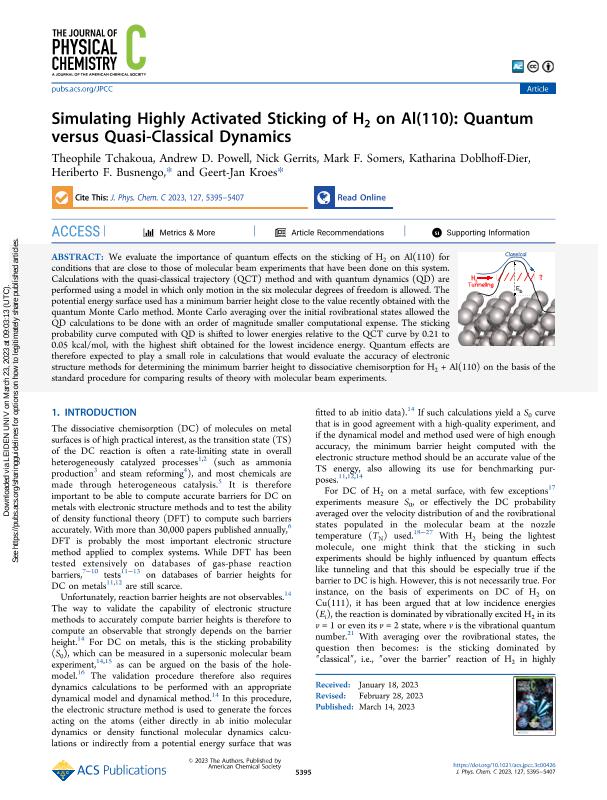Mostrar el registro sencillo del ítem
dc.contributor.author
Tchakoua, Theophile
dc.contributor.author
Powell, Andrew D.
dc.contributor.author
Gerrits, Nick
dc.contributor.author
Somers, Mark F.
dc.contributor.author
Doblhoff Dier, Katharina
dc.contributor.author
Busnengo, Heriberto Fabio

dc.contributor.author
Kroes, Geert Jan
dc.date.available
2024-04-19T13:12:04Z
dc.date.issued
2023-03
dc.identifier.citation
Tchakoua, Theophile; Powell, Andrew D.; Gerrits, Nick; Somers, Mark F.; Doblhoff Dier, Katharina; et al.; Simulating Highly Activated Sticking of H2on Al(110): Quantum versus Quasi-Classical Dynamics; American Chemical Society; Journal of Physical Chemistry C; 127; 11; 3-2023; 5395-5407
dc.identifier.issn
1932-7447
dc.identifier.uri
http://hdl.handle.net/11336/233569
dc.description.abstract
We evaluate the importance of quantum effects on the sticking of H2on Al(110) for conditions that are close to those of molecular beam experiments that have been done on this system. Calculations with the quasi-classical trajectory (QCT) method and with quantum dynamics (QD) are performed using a model in which only motion in the six molecular degrees of freedom is allowed. The potential energy surface used has a minimum barrier height close to the value recently obtained with the quantum Monte Carlo method. Monte Carlo averaging over the initial rovibrational states allowed the QD calculations to be done with an order of magnitude smaller computational expense. The sticking probability curve computed with QD is shifted to lower energies relative to the QCT curve by 0.21 to 0.05 kcal/mol, with the highest shift obtained for the lowest incidence energy. Quantum effects are therefore expected to play a small role in calculations that would evaluate the accuracy of electronic structure methods for determining the minimum barrier height to dissociative chemisorption for H2+ Al(110) on the basis of the standard procedure for comparing results of theory with molecular beam experiments.
dc.format
application/pdf
dc.language.iso
eng
dc.publisher
American Chemical Society

dc.rights
info:eu-repo/semantics/openAccess
dc.rights.uri
https://creativecommons.org/licenses/by/2.5/ar/
dc.subject
SUPERFICIES
dc.subject
ABINITIO
dc.subject.classification
Física Atómica, Molecular y Química

dc.subject.classification
Ciencias Físicas

dc.subject.classification
CIENCIAS NATURALES Y EXACTAS

dc.title
Simulating Highly Activated Sticking of H2on Al(110): Quantum versus Quasi-Classical Dynamics
dc.type
info:eu-repo/semantics/article
dc.type
info:ar-repo/semantics/artículo
dc.type
info:eu-repo/semantics/publishedVersion
dc.date.updated
2024-04-19T12:17:41Z
dc.journal.volume
127
dc.journal.number
11
dc.journal.pagination
5395-5407
dc.journal.pais
Estados Unidos

dc.description.fil
Fil: Tchakoua, Theophile. Leiden University; Países Bajos
dc.description.fil
Fil: Powell, Andrew D.. Leiden University; Países Bajos
dc.description.fil
Fil: Gerrits, Nick. Leiden University; Países Bajos
dc.description.fil
Fil: Somers, Mark F.. Leiden University; Países Bajos
dc.description.fil
Fil: Doblhoff Dier, Katharina. Leiden University; Países Bajos
dc.description.fil
Fil: Busnengo, Heriberto Fabio. Consejo Nacional de Investigaciones Científicas y Técnicas. Centro Científico Tecnológico Conicet - Rosario. Instituto de Física de Rosario. Universidad Nacional de Rosario. Instituto de Física de Rosario; Argentina
dc.description.fil
Fil: Kroes, Geert Jan. Leiden University; Países Bajos
dc.journal.title
Journal of Physical Chemistry C

dc.relation.alternativeid
info:eu-repo/semantics/altIdentifier/doi/http://dx.doi.org/10.1021/acs.jpcc.3c00426
Archivos asociados
